Due to the climate and energy crises, much discussion has focused on the anticipated ‘transition’ from fossil fuels for energy production to cleaner alternative sources of energy. Consequently, terrestrial energy sources such as solar and wind are being deployed at an increasing pace, yet these represent only a small percentage of the current global energy mix whereas overall energy production from fossil fuels including transportation and manufacturing remains at about 82% and while 61% of today’s electricity production is generated by fossil fuels.
While valuable and necessary, no combination of terrestrial energy sources including nuclear, wind, solar, and hydroelectricity can be deployed on a sufficient scale to reliably power modern civilisation, and to provide adequate energy for developing countries to escape poverty. But energy from space CAN, if we move quickly. Therefore, what is urgently needed is nothing less than a ‘transformation’ of the Fossil Fuel Age into the Space Energy Age.
World Energy Consumption and World Electricity Production
Using data from the 2024 Energy Institute Statistical Review of World Energy, total world energy consumption in 2023 was 620 Exajoules (EJ) or 172,121 TWh when converted into Terawatt-hours an increase of about 2.7% from 2022 (604 Exajoules (EJ) or 167,789 TWh) Energy Institute, 2024, page 13. A year has 8,760 hours which indicates that it takes about 19.6 TW of energy production capacity to power today’s civilisation. 19.6 TW equals 19,600 GW. As the population and economic development continue to increase, humanity’s energy needs are expected to increase by 50% to about 30 TW by 2050.
 Source: Energy Institute: 2024 Statistical Review of World Energy
Source: Energy Institute: 2024 Statistical Review of World Energy
In 2023, combined fossil fuel use – oil, natural gas and coal – for all types of energy production was 504.83 Exajoules or about 140 TWh. A typical nuclear power station rated at 1-GW operating with an availability of 90% produces 7,884 GWh of electrical power per year. Thus, to replace 2023 fossil fuel use with nuclear power would require 17,760 new 1-GW nuclear power stations. This is unlikely to happen.
Availability means the amount of time a device is in operation as the percentage of total time it should be operating. For power generation, availability is calculated by dividing the amount of time during which a power plant is able to produce electricity over a certain period, by the total amount of time in that period.
Fossil fuels were used to generate 17,975 TWh of electricity in 2023. To replace fossil fuel electricity generation with nuclear energy would require 2,280 new 1-GW nuclear power stations. Today, there are 437 nuclear power plants (Statista, 2023) in operation which provided 2,738 TWh of electricity in 2022 (Energy Institute, 2024, page 56). In Europe, the current cost to build a new nuclear power station is about CHF 9 billion per GW. Adding just 100 GW of nuclear power would cost approximately CHF 900 billion.
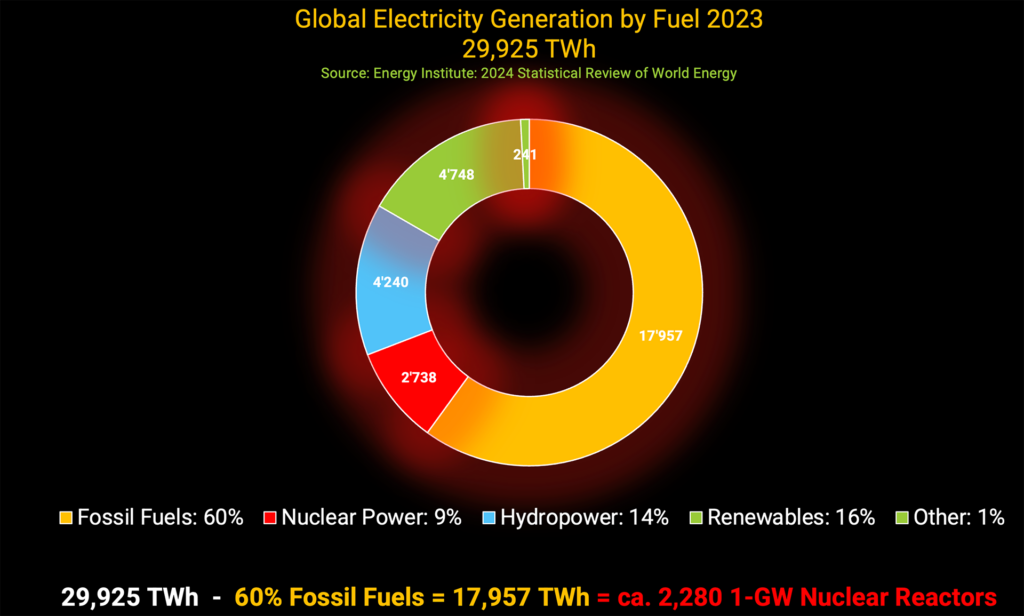
Electricity Generation by Fuel 2023. Source: Energy Institute: 2024 Statistical Review of World Energy
Depending on the geographical location, wind power has an availability of about 20-35% (Switzerland = 22.17%) and solar power about 12-25% (Switzerland = 11.48%). Thus, the generating capacity of wind power would have to be 3-5 times higher and solar power about 4-6 times higher than nuclear power to provide an equivalent amount of electrical power. However, as wind and solar are intermittent sources of energy, they do not supply continuous or baseload energy as do fossil fuels and nuclear. According to the Energy Institute 2024 Statistical Review of World Energy, in 2023, wind power provided 2,325 TWh and terrestrial solar 1,642 TWh or just 3,967 TWh combined. Hydroelectricity provided 4,240 TWh. Electricity from all renewables combined in 2023 was 8,988.4 TWh.
For numerous environmental, geopolitical, economic and geological reasons, not the least of which is their accessibility and affordability, humanity must urgently find an alternative to fossil fuels. The global economy is recognizing that fossil fuels reserves are becoming more expensive and more difficult to extract. High oil prices are needed to justify drilling in new locations to increase oil production. However, continuous rising prices can make fossil fuels unaffordable, leading to potential economic challenges. Also, fossil fuels are becoming too valuable to be used for energy production as they are needed for plastics, manufacturing, medical and pharmaceuticals, heavy transportation and fertilizer.
The Bad News about Fossil Fuels:
- Fossil Fuels are bad for the environment.
- Fossil Fuels are often subsidized to an extent that distorts the energy market.
- Fossil Fuels are finite and are becoming more difficult and expensive to extract.
- Fossil Fuels are a source of geopolitical conflict.
- Terrestrial alternative energy sources cannot scale sufficiently to replace fossil fuels.
The Good News about Fossil Fuels:
- Fossil fuels have enabled a modern society.
- Fossil Fuels have increased prosperity and economic welfare.
- Fossil Fuels have promoted global development.
- Fossil Fuels have been easily available, cost-effective and reliable.
- Fossil Fuels have enabled humanity to inaugurate the Space Energy Age.
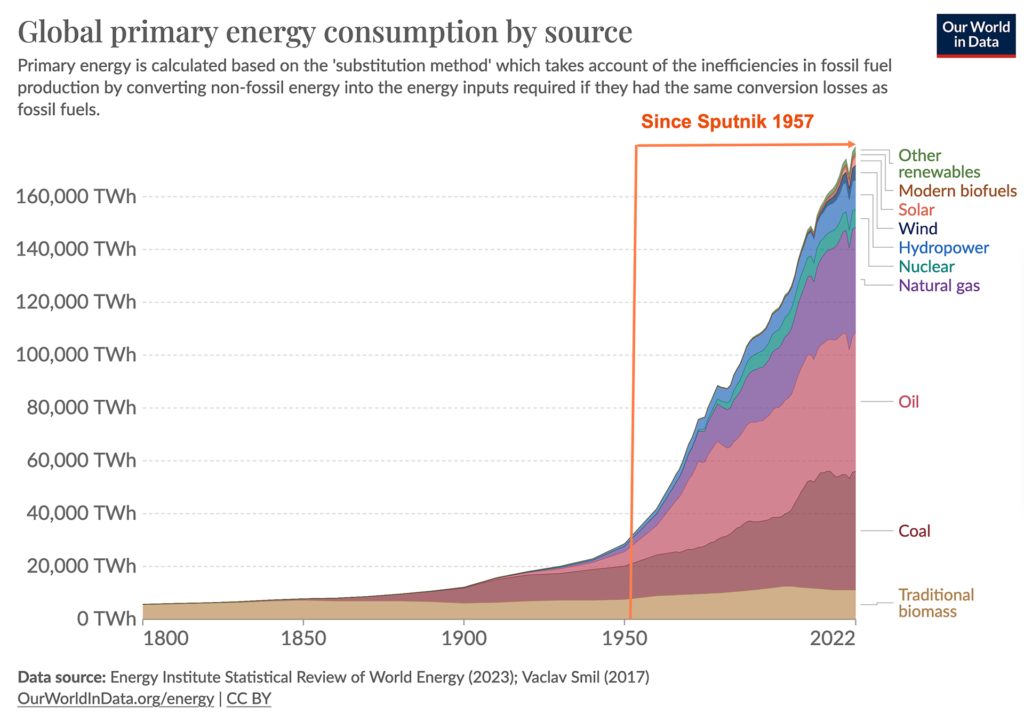
Fossil fuels used for energy since 1957 (Our World in Data)
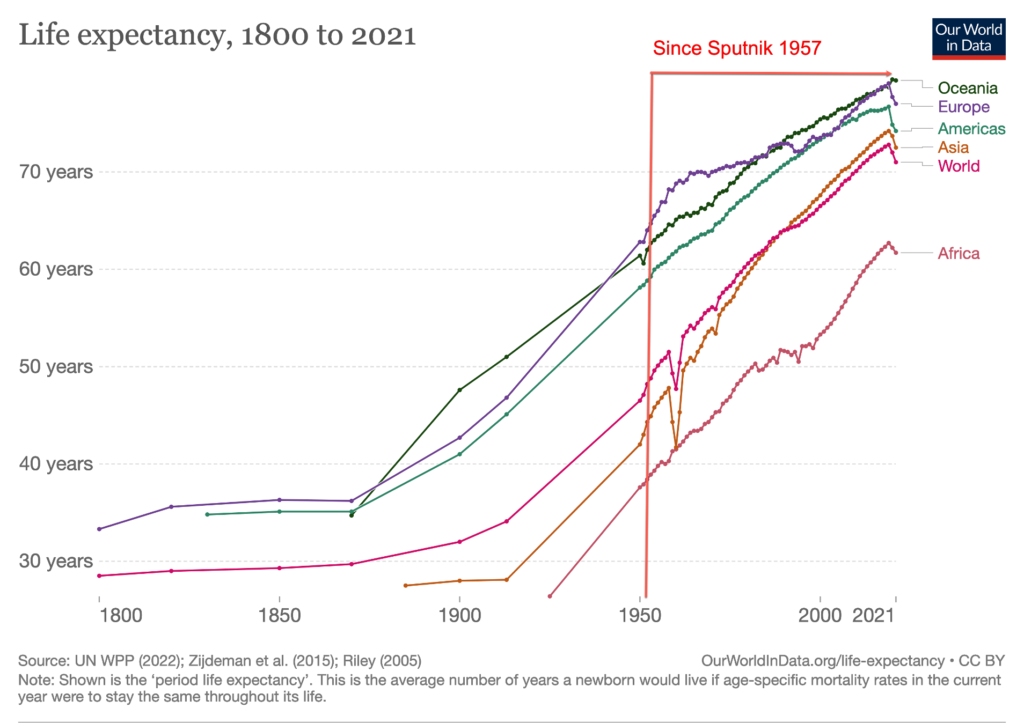
Fossil fuels have resulted in an increase in life expectancy (Our World in Data)
The Space Energy Option
Today, Space-Based Solar Power (SBSP) is being researched around the world as a potential space energy option to end humanity’s dependence on using fossil fuels for energy production. SBSP has the potential to supply clean, baseload power from space to Earth on a very large scale, enabling nations to simultaneously meet their energy security and climate goals.
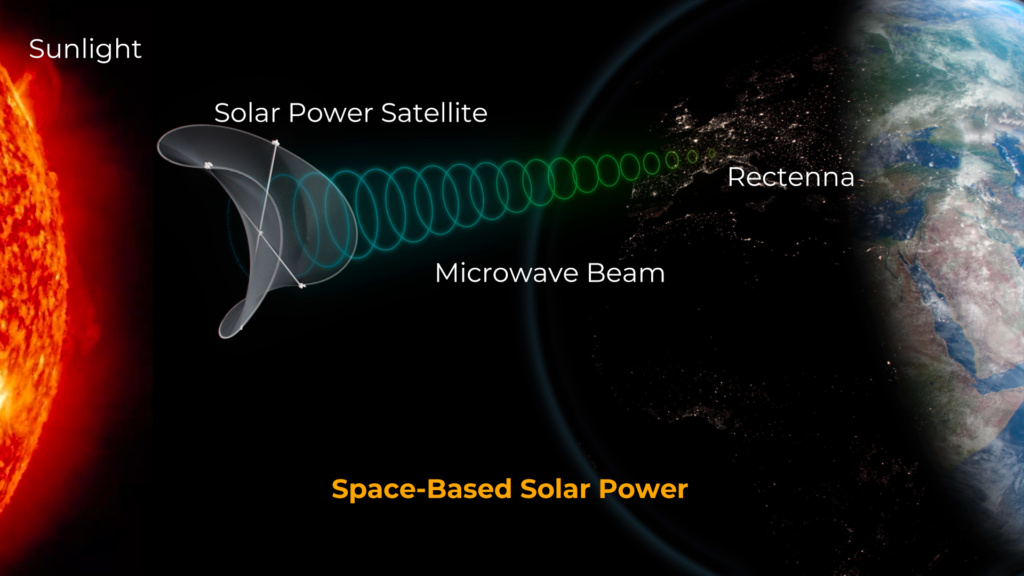
SBSP Diagram
In terms of power capacity, availability and environmental impact, SBSP is superior to all other sources of energy production and is the future energy option to power civilisation. A Solar Power Satellite (SPS) operating with a 99% availability and with a rated power to the grid of 1.44 GW would provide 14.43 TWh/year of electricity. As such, approximately 215 SPSs for the world, and 59 SPSs for Europe would be required to supply the equivalent electricity as does nuclear power today. 1,415 SPSs (1.44 GW) would be necessary to replace the 17,667 TWh of electricity that was generated by fossil fuels in in 2022.
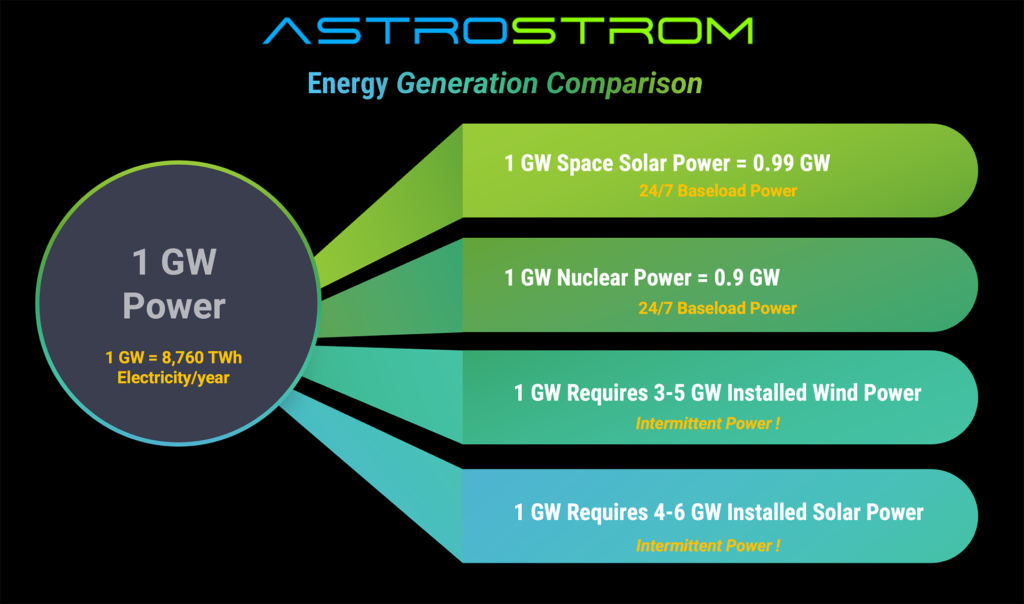
Comparing Availability of Energy Generation Systems
However, a major obstacle to developing SBSP to become a major source of energy is the logistical challenge of launching 100’s and eventually 1,000’s of heavy-lift rockets from the Earth’s surface to deploy Solar Power Satellites (SPS) in geostationary orbit (GEO) that are more than one kilometre in diameter and weigh 1000’s of tonnes.
Astrostrom GmbH is the only company that is currently pursuing an approach to SBSP that includes manufacturing solar power satellite (SPS) components on the Moon from lunar materials. This approach would greatly mitigate both the launch capacity bottleneck and the environmental impact of SBSP, while also reducing the costs of manufacturing and deploying future solar power satellites by reducing the amount of mass launched into orbit per SPS by 80% or more.
In the framework of the European Space Agency’s (ESA) open call “Clean Energy from Space” which sought novel ideas related to SBSP systems, Astrostrom GmbH was awarded a contract to investigate the feasibility of a “Greater Earth Lunar Power Station” (GE⊕-LPS) manufactured on the Moon and assembled at the Earth-Moon Lagrange Point 1 (EM-L1) to provide power from lunar orbit to operations on the surface of the Moon. Once the initial station is in operation, the production facilities on the lunar surface encompassing beneficiation, processing, and fabrication could be then used to produce additional Solar Power Satellites (SPS) to be shipped into Earth orbits to deliver clean baseload solar energy to Earth. The results of this study were published by ESA in May 2023. Due to the success and the impact of this study, Astrostrom has emerged as a key innovator in the field of SBSP.
Astrostrom’s first goal is to provide the same amount of electrical power in 2050 as nuclear power provides today which was 2,679 TWh for the world and 741.5 TWh in Europe. These are taken as the initial SPS electricity production targets of the proposed Astrostrom/GEEO PPP that could be achieved by 2050. Replacing fossil fuels for electricity generation by the year 2100 is the next goal.
To transform the Fossil Fuel Age into the Space Energy Age, a visionary approach similar to the ‘Apollo Programme’ will be needed to develop and implement SBSP at the necessary scale and in the time frame to make a difference.
- The first SPS for lunar operations could be developed within 10 years.
- The first SPS for Earth could be operational by 2040.
- An equivalent amount of energy as is provided by nuclear power today could be delivered from space to Earth by 2050.
- SBSP could replace fossil fuels for electrical generation by 2100.
ASTROSTROM is seeking strategic partners and investors to set up the Greater Earth Energy Organisation (GEEO) to implement SBSP.
To find out how you can profit from this unprecedented opportunity that will transform the Fossil Fuel Age into the Space Energy Age, please send us an inquiry.
References:
- Energy Institute: 2024 Statistical Review of World Energy (2023)
https://www.energyinst.org/statistical-review - Statista, (2023). Number of operable nuclear power reactors worldwide as of May 2023
https://www.statista.com/statistics/267158/number-of-nuclear-reactors-in-operation-by-country/ - International Energy Agency, (IEA) Energy Systems, Renewables (2023)
https://www.iea.org/energy-system/renewables - Our World in Data, (2024) Global primary energy consumption by source
https://ourworldindata.org/grapher/global-energy-substitution - Our world in Data, (2024) Life expectancy at birth
https://ourworldindata.org/grapher/life-expectancy - GE⊕-LPS Final Report (2023) (ESA Contract No: 4000136309/21/NL/GLC/ov.) https://astrostrom.ch/docs/GE⊕-LPS-Final-Report_June_2023.pdf
- ESA: Nebula Archive: GE⊕ Lunar Power Station (2023)
https://nebula.esa.int/content/ge%E2%8A%95-lunar-power-station






